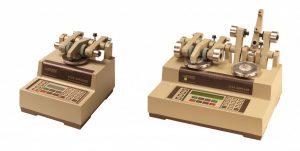Will Parylene Pass a Taber Test?
Posted by Sean Horn
Friday, July 13, 2018 7:30
@ 7:30 AM
Taber tests are designed to measure a material’s capacity to withstand abrasion and its effects during operation. Conformal coatings – both liquid and parylene (XY) – are
- used on printed circuit boards (PCBs) and related electrical assemblies
- to safeguard their function from hostile environments,
- where operational conditions could lead to development
- of abrasion, arcing, electrical shorting, fungus, internal moisture, and other incidents detrimental to function.
In the case of abrasion, coatings are subjected to Taber Abrasion testing to determine their resistance during prolonged use. As in most other cases of comparative performance, CVD-applied XY surpasses liquid coatings – acrylic, epoxy, silicone, urethane – in Taber scores.
CVD is the acronym for chemical vapor deposition, a method of conformal film application unique to parylene. Pre-synthesized liquid coatings brush, dip or spray wet conformal material onto substrates, providing an often effective, but limited, protective covering, confined to external surfaces only. Parylene synthesizes in-process, transforming from a solid (powdered dimer material) into a gas that deposits both into and onto substrates. By penetrating the substrate’s surface, as well as adhering externally, XY provides additional conformal protection — pinhole free, adapting to any topography. This property adds to parylene’s ability to withstand operational abrasion.
Nevertheless, quality control guidelines at Diamond, and responsible providers of conformal coating throughout the industry, demand accountable assessment of all aspects of the coating process. Because substrate coatings can be damaged by abrasion during manufacturing and service, methods of assuring they meet performance standards are necessary. Among professional standards measured by the Taber Abrader, ISO 7784–2 — Paints and varnishes/Determination of resistance to abrasion/Part 2: Rotating abrasive rubber wheel method — devised by the American National Standards Institute (ANSI), is the most prominent. For parylene, other pertinent performance criteria applicable to Taber testing for XY include:
- American Society for Testing and Materials (ASTM) International D4060 – 14. Designated the “Standard Test Method for Abrasion Resistance of Organic Coatings,” it stipulates the resistance levels of organic coatings to abrasion produced by the Taber Abrader on conformal films applied to plane, rigid surfaces, such as a metal panel.
- ASTM D823 specifies Practices for Producing Films of Uniform Thickness of Paint, Varnish, and Related Products on Test Panels.
- ASTM D968 identifies Test Methods for Abrasion Resistance of Organic Coatings by Falling Abrasive.
- ASTM D1005 details Test Method for Measurement of Dry-Film Thickness of Organic Coatings Using Micrometers.
- ASTM G1195 is a Guide for Conducting Wear Tests Using a Rotary Platform Abrader.
In practice, Taber Rotary Abrader (TRS) testing attaches a level, uniform, square or round substrate specimen, measuring about 100mm., to a vertically-axised turntable platform, rotating at a fixed speed. TRS accommodates materials to a thickness of 6.35 mm., although optional accessories can expand the testing range from > 6.35 mm. to < 40 mm. Two Taber abrasive wheels are lowered to the specimen, moving across the surface at a level of pressure specific to its abrasion-resistance requirements. While one abrading wheel rubs the specimen inward toward its center, the second scrapes outward, toward the specimen’s periphery. As the wheels complete a circle across the specimen surface, abrasion resistance is revealed at all angles, relative to the material’s grain or weave. Abrasion markings’ circular pattern of crossed arcs cover about 30 cm.2 along the specimen; a vacuum system removes loose debris during the test.

Methods of assessing TRS results include:
- Taber Wear Index (TWI) – Calculated by measuring the loss in milligram-weight per thousand cycles of abrasion, providing the rate of surface wear of a conformal coating; lower wear index values indicate better abrasion resistance.
- Mass (Weight) Loss – Typically reported in milligrams, measuring the quantity of coating material removed by abrasion. It is important to clean test specimens before measurement, to assure loose particulate do not adhere to their surface.
- Wear Cycles per Mm. calculates the number of abrasion cycles necessary to breach a coating of a known thickness.
Like other conformal coating’s XY’s abrasion rate is based on the coated item’s surface area and the force applied to it. Regardless of the material, abrasion rate of wear is a function of abrasion force: greater force causes greater wear; smaller areas also abrade faster than larger. Parylene passes TRS, with exceptional results, compared to liquid coatings.
In one study, TWI values (measured on a Tabor Abrader machine using CS-17 Calibraser wheels and 1000-gram weights) were 22.5 for parylene C and 8.8 for parylene N. By comparison, Teflon — polytetrafluoroethylene (PTFE), a synthetic fluoropolymer – was 8.4, high impact PVC was 24.4, epoxy 41.9 and urethane 59.5. Since lower TWI values indicate greater performance, parylene scores exceeded all but PTFE.
In general, parylene coated objects resist abrasion better than even exceptionally hard liquid coatings like epoxy. Another test showed parylene C coated at 25 microns abraded through a distance of nearly 9 meters before substrate exposure; in comparison, epoxy at 25 microns failed after only 1.2 meters. In this study, XY’s abrasion resistance at 2.5 microns was equivalent to 7.5 microns of epoxy. Table 1 shows parylene wear index values in relation to those of wet coatings epoxy and urethane.
TABLE 1 – Taber Wear Index for Conformal Coating Materials
Thickness ( cm )
Material .005- .0075 .075 – 0.125 0.97
Parylene N – 9 –
Parylene C – 29 –
Urethane 23 + 2 60 62 + 2
Epoxy 30 + 10 42 60 + 4
To learn more about parylene and abrasion issues, download our whitepaper now:
Download our guide on Parylene 101
Comments
Homepage 4/17/2020. 10:17:10 AM
... [Trackback] [...] Informations on that Topic: blog.paryleneconformalcoating.com/whats-the-difference-between-potting-and-conformal-coating/ [...]

londondrugscanada.bigcartel.comlondon-drugs 4/17/2020. 10:17:10 AM
cialis uk https://londondrugscanada.bigcartel.com/london-drugs This is nicely expressed. !